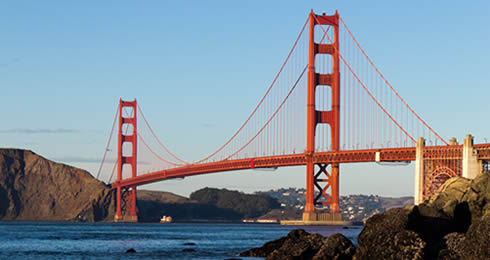
The Golden Gate Bridge: When Living Art Becomes a Way to Die
- A higher railing was recommended for the Golden Gate Bridge, but it was overruled.
- The four main arguments against a GG bridge suicide barrier
- What is the rail height of the newly opened SF-Oakland Bay Bridge span, and how many months did it take to discuss the suicide issue?
- Was architect Donald MacDonald overruled or was the new Bay Bridge railing height his preference?
- Why should we care?
Close to 1,600 people have committed suicide off the GG Bridge since it opened in 1937. The year 2013 saw the highest number of suicides since the first man took his life three months after the bridge opened. In spite of the numbers, it has taken almost 70 years for the bridge and transportation agencies to agree to install a suicide barrier. The motion to approve funding came from the former bridge district director John Moylan – whose grandson, Sean, jumped to his death this past month.
Joseph Strauss recommended a higher railing for the Golden Gate, but was overruled.
Chief Engineer Joseph Strauss’s original designs called for a 67” pedestrian walkway rail, capped in a manner that made it difficult to grasp. Later architect Irving Morrow lowered the rail height to 48” to provide for a better view.
In social isolation Morrow’s change could be viewed as naive, but within the context of the Great Depression and subsequent rise in suicide from 1925-1932, Morrow chose aesthetics over the inherent liability of a low rail.
What have been the arguments against a GG Bridge suicide barrier?
The San Francisco Chamber of Commerce, “design-sensitive” activists and local power brokers based their opposition on the following arguments:
- Suicide is a human right. (It is a right many might regret exercising if they were given a second chance, some time and personal attention).
- A barrier is a blot on the most beautiful bridge in the world. (Even if the barrier design is noticeable, sacrificing life for aesthetics is hard to support.)
- It isn’t good for tourism to think of San Francisco and suicide in the same breath. (San Francisco’s tourism survived the 1960’s drug era and the 80’s AIDS epidemic, and it will survive being honest about the dark side of the Golden Gate Bridge. People pay to visit geography that has hosted tragedy, and that won’t change.)
- Depressed people will only find another bridge. (There were no increases in nearby bridge suicides after barriers were installed on the Bristol’s Clifton suspension bridge in UK or on the Washington DC Bridge in US.)
As serious discussion of a barrier was delayed decade after decade, the number of suicides steadily increased and those jumping were younger and younger. Finally, the local opposition to a barrier became a local embarrassment: the GG Bridge is the only international landmark that does not have a suicide barrier.
Given a second chance, what is the rail height of the newly opened SF-Oakland Bay Bridge span?
The new SF-Oakland Bay Bridge span is 55 inches, which brings three questions to mind:
- Can a 55” inch rail be easily cleared by a person of average height?
- Would a higher rail have created a financial burden and delayed the span replacement?
- Did the design team meet their obligation to protect the public’s health, safety and welfare—especially considering the local history of bridge suicide?
The answers in order: Yes, no, and highly debatable.
Granted, we can’t and shouldn’t make suicide prevention central to every architectural/engineering design decision; however, repeating a local problem rather than correcting it says a lot about the San Francisco Bay Area culture. While the Bay Bridge has never had the suicide draw of the Golden Gate, there is a history of people jumping from the Bay Bridge.
How many months did it take to resolve the suicide issue on the new Bay Bridge span?
In the March 2006 SF Gate article John Kriken, vice chairman of the committee to assess the Bay Bridge design said:
“…while the railing height was discussed, the emphasis was on providing ‘a sense of comfort’ for people. We didn’t discuss whether people could climb over,” he said. “Suicide was not discussed.”
The Golden Gate Bridge and Bay Bridge are within sight lines of each other. Does Kriken really expect people to believe that in the years of planning for the new Bay Bridge span, suicide was not discussed? If so, one wonders who Dr. Mel Blaustein, head of psychiatry at St. Francis Hospital and president of the Psychiatric Foundation of Northern California, addressed when publicly lobbying to raise the new span’s railing to 72”?
Was architect Donald MacDonald, like Strauss, overruled or was the new Bay Bridge railing height his preference?
The answer doesn’t seem to be easily determined, but in the same 2006 SF Gate article referenced above, MacDonald, who was the architect for the walkway and bicycle path, states:
(The new span’s)…”railings stand 7 inches taller than those on the Golden Gate and are a little harder to jump over. But anyone hell-bent on jumping could do it.”
At least MacDonald speaks to reality – even though, if Kriken is to be believed – MacDonald never discussed the public area in terms of risk of suicide.
- Suicide is not only contagious, it is now epidemic—affecting all socio-economic levels.
- Suicide will inevitably hit a home and/or school near the reader—if it hasn’t already.
- The time to argue about whether we should make an effort to prevent vs. permit inviting suicide opportunities is over.
- We need to stop debating whether suicide is a civil right as if we are talking about elderly end-of-life decisions.
- We are often talking about teenagers whose only emotional problem is their inability to put a current social rejection into future perspective.
The World Health Organization reports the suicide rate has increased 60% globally over the past 50 years. Every year, since the 1990’s, close to 30,000 Americans commit suicide, 800,000 attempt it and the lives of the 5,000,000 surviving family members are forever shattered.
Keep in mind that
- a suicidal person’s goal is not to end their life, but to end their pain; and
- if stopped after a first attempt they often abandon the desire and get help.
Where should we focus the money?
Some observers have suggested the money for the GG Bridge barrier would have been better spent on mental health programs to screen children, early, for depression and emotional problems. It’s too late for such an either/or argument. We need both in place—and soon.
For those readers who don’t like to spend money on troubled people and for those who don’t understand the difference between an entitlement and an investment, sharpen your pencil. You are going to hate the cost if you continue to turn away from understanding the impact of what isn’t pleasant to think about.
Additional Reading
See a picture of the new Bay Bridge span’s pedestrian walkway rail
http://www.sfgate.com/bayarea/article/Bay-Bridge-suicides-feared-New-span-to-have-2502150.php
Read recent NYT article “Is the World More Depressed” by T.M. Luhrmann, professor of anthropology at Stanford University, addresses the reason for the rise in depression. http://www.nytimes.com/2014/03/25/opinion/a-great-depression.html?_r=0
Listen to the audio “Hope for Our Future Selves,” a Public Radio On Being interview with Jennifer Hecht, author of Stay.
http://www.onbeing.org/program/jennifer-michael-hecht-hope-for-our-future-selves/20140327
Passage from Hecht’s book Stay
None of us can truly know what we mean to other people, and none of us can know what our future self will experience. History and philosophy ask us to remember these mysteries, to look around at friends, family, humanity, at the surprises life brings–the endless possibilities that living offers–and to persevere. There is love and insight to live for, bright moments to cherish, and even the possibility of happiness, and the chance of helping someone else through his or her own troubles.
Know that people, through history and today, understand how much courage it takes to stay. Bear witness to the night side of being human and the bravery it entails, and wait for the sun. If we meditate on the record of human wisdom we may find there reason enough to persist and find our way back to happiness. First, choose to stay (page 234).
Order Hecht’s book: Stay: A History of Suicide and the Philosophies Against It






























